Highlights
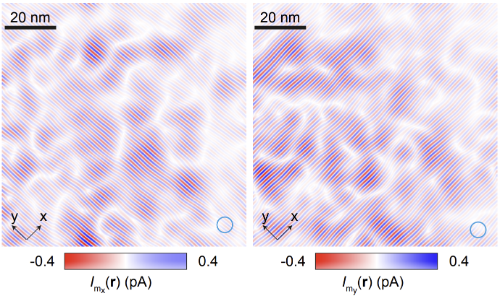
Electron-pair density wave (PDW) states are now an intense focus of research in the field of cuprate correlated superconductivity. PDWs exhibit periodically modulating superconductive electron pairing that can be visualized directly using scanned Josephson tunneling microscopy (SJTM). Although from theory, intertwining the d-wave superconducting (DSC) and PDW order parameters allows a plethora of global electron-pair orders to appear, which one actually occurs in the various cuprates is unknown. Here, we use SJTM to visualize the interplay of PDW and DSC states in Bi2Sr2CaCu2O8+x at a carrier density where the charge density wave modulations are virtually nonexistent. Simultaneous visualization of their amplitudes reveals that the intertwined PDW and DSC are mutually attractive states. Then, by separately imaging the electron-pair density modulations of the two orthogonal PDWs, we discover a robust nematic PDW state. Its spatial arrangement entails Ising domains of opposite nematicity, each consisting primarily of unidirectional and lattice commensurate electron-pair density modulations. Further, we demonstrate by direct imaging that the scattering resonances identifying Zn impurity atom sites occur predominantly within boundaries between these domains. This implies that the nematic PDW state is pinned by Zn atoms, as was recently proposed [Lozano et al., Phys. Rev. B 103, L020502 (2021)]. Taken in combination, these data indicate that the PDW in Bi2Sr2CaCu2O8+x is a vestigial nematic pair density wave state [Agterberg et al. Phys. Rev. B 91, 054502 (2015); Wardh and Granath arXiv:2203.08250].
published article
(Proc. Nat'l Acad. Sci. 119, 2206481119 - July 2022)
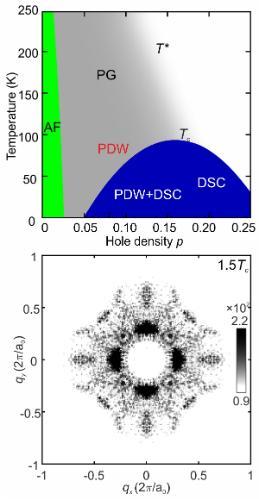
An unidentified quantum fluid designated the pseudogap (PG) phase is produced by electron-density depletion in the CuO2 antiferromagnetic insulator. Current theories suggest that the PG phase may be a pair density wave (PDW) state characterized by a spatially modulating density of electron pairs. Such a state should exhibit a periodically modulating energy gap ΔP(r) in real-space, and a characteristic quasiparticle scattering interference (QPI) signature ΛP(q) in wavevector space. By studying strongly underdoped Bi2Sr2CaDyCu2O8 at hole-density ~0.08 in the superconductive phase, we detect the 8a0-periodic ΔP(r) modulations signifying a PDW coexisting with superconductivity. Then, by visualizing the temperature dependence of this electronic structure from the superconducting into the pseudogap phase, we find evolution of the scattering interference signature Λ(q) that is predicted specifically for the temperature dependence of an 8a0-periodic PDW. These observations are consistent with theory for the transition from a PDW state coexisting with d-wave superconductivity to a pure PDW state in the Bi2Sr2CaDyCu2O8 pseudogap phase.
published article
(Nature Communications 12, 6087 - Oct 2021)
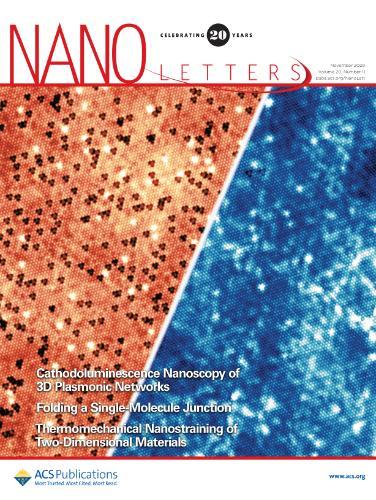
The quantum anomalous Hall (QAH) effect appears in ferromagnetic topological insulators (FMTIs) when a Dirac mass gap opens in the spectrum of the topological surface states (SSs). Unaccountably, although the mean mass gap can exceed 28 meV (or ~320 K), the QAH effect is frequently only detectable at temperatures below 1 K. Using atomic-resolution Landau level spectroscopic imaging, we compare the electronic structure of the archetypal FMTI Cr0.08(Bi0.1Sb0.9)1.92Te3 to that of its nonmagnetic parent (Bi0.1Sb0.9)2Te3, to explore the cause. In (Bi0.1Sb0.9)2Te3, we find spatially random variations of the Dirac energy. Statistically equivalent Dirac energy variations are detected in Cr0.08(Bi0.1Sb0.9)1.92Te3 with concurrent but uncorrelated Dirac mass gap disorder. These two classes of SS electronic disorder conspire to drastically suppress the minimum mass gap to below 100 µeV for nanoscale regions separated by <1 µm. This fundamentally limits the fully quantized anomalous Hall effect in Sb2Te3-based FMTI materials to very low temperatures.
(Nano Lett. 2020, 20, 8001-8007 - Nov 2020)
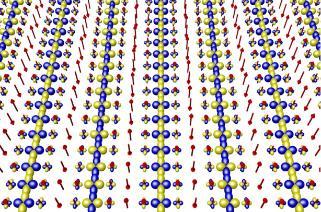
The defining characteristic of Cooper pairs with finite center-of-mass momentum is a spatially modulating superconducting energy gap Δ(r). Recently, this concept has been generalized to the pair density wave (PDW) state predicted to exist in high temperature superconducting cuprates (ARCMP 11, 231 (2020)). Although the existence of a PDW in cuprates was discovered by using Cooper-pair tunneling (Nature 532, 343 (2016)), its signature in single-electron tunneling of periodic Δ(r) modulations, proved elusive. Now, by using a new approach, we detect strong Δ(r) modulations in Bi2Sr2CaCu2O8+δ that have eight-unit-cell periodicity or wavevectors Q ≈ 2π/a0 (1/8,0); 2π/a0 (0,1/8). Simultaneous imaging of the local-density-of-states N(r,E) reveals electronic modulations with wavevectors Q and 2Q, as anticipated for a coexisting superconductor and PDW. Overall, this provides strong confirmation that a PDW state coexists with superconductivity in the canonical cuprate Bi2Sr2CaCu2O8+δ. These results were published in Nature 580, 65-70 (April 2020).
published article - download PDF
(Nature 580, 6570 - April 2020)
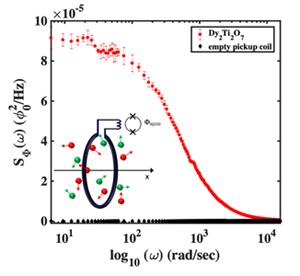
Magnetic monopoles are highly elusive elementary particles exhibiting quantised magnetic charge. The prospect for studying them has brightened in recent years with the theoretical realisation that, in certain classes of magnetic insulators, the thermally excited states exhibit all the characteristics of magnetic monopoles. Specifically, recent theories predicted that these magnetic insulators should spontaneously generate wildly and randomly fluctuating magnetic fields as the monopoles move around, but with a magnitude near one billionth of the Earth’s field. Using an exquisitely sensitive magnetic-field-noise spectrometer based on a superconducting quantum interference device (SQUID), we detected from crystals of Dy2Ti2O7 virtually all the predicted features of the magnetic noise coming from a dense fluid of magnetic monopoles. Extraordinarily, because this magnetic monopole noise occurs in the frequency range below 20kHz, when amplified by the SQUID it is actually audible to humans as exemplified in this video clip.
published article - download PDF
(Nature 571, 234 - Jul 2019)
See also - Oxford Science Blog / Phys.org
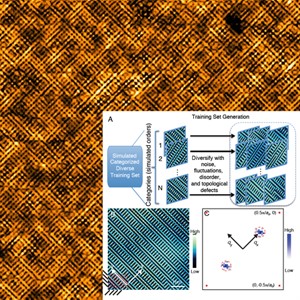
A collaboration of experimental physicists led by Prof. JC Séamus Davis (University of Oxford), theoretical physicists led by Prof. Eun-Ah Kim (Cornell University), and computer scientists led by Prof. E. Kathami (San Jose State University), developed and trained a new Machine Learning (ML) protocol, based on a suite of artificial neural networks (ANN), that is designed to recognize different types of electronic ordered states which are hidden within electronic quantum matter image-arrays.
Electronic quantum matter studies using automated scientific instrumentation and large-scale data acquisition are now generating data sets of such volume and complexity as to defy human analysis. For example modern scanning tunneling microscopy (STM) visualization of electronic quantum matter (EQM) yields dense arrays of atomic-scale, electronic-structure images, that are often astonishingly complex.
The ANN suite analyzed one of the Davis Group experimental EQM image archives, spanning a wide range of electron densities and energies, in carrier-doped cuprate Mott insulators. The ANN suite discovered, throughout all the noisy and complex data, the features of a very specific ordered state of EQM: a Vestigial Nematic State.
This is a milestone for general scientific technique in that ANN’s can process and identify specific broken symmetries of highly complex image-arrays from non-synthetic experimental EQM data. It opens the immediate prospect of additional ML-driven scientific discovery in EQM studies.
published article - download PDF
(Nature 570, 484 - Jun 2019)
See also - Phys.org / Science Daily / EE News Analog
EE journal / Silicon Republic / Science Codex
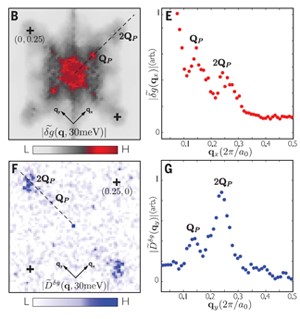
Superconductivity occurs when electrons form pairs of opposite spin and opposite momentum, and these "Cooper pairs" condense into a homogeneous electronic fluid. However, theorists have recently realized that these electron pairs might also crystallize into a “pair density wave” (PDW) state where the density of pairs modulates periodically in space. Intense theoretical interest has emerged in whether such a PDW is the competing phase in cuprates. To search for evidence of such a PDW state we suppress the homogeneous superconductivity using high magnetic field and visualize the electronic structure of the new phase which appears. Under these circumstances we discovered modulations in the density of electronic states containing multiple signatures of a PDW state. The phenomena are in detailed and excellent agreement with theoretical predictions for a field-induced primary PDW state. These data indicate that it is a PDW state which competes with superconductivity in cuprates and that it dominates in the high-field regime.
published article - download PDF
(Science 364, 976 - Jun 2019)
See also - Phys.org / Science Daily / EurekaAlert
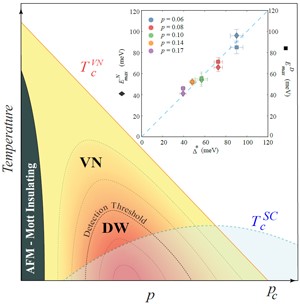
In the cuprate pseudogap phase, an energy gap of unknown mechanism opens, and both an electronic nematic phase (NE) and a density-wave (DW) phase appear. Perplexingly, the DW, which should generate an energy gap, appears without any new gap opening; and the NE, which should be incapable of opening an energy gap, emerges coincident with the pseudogap opening. Recently, however, it was demonstrated theoretically that a disordered unidirectional DW can generate a vestigial nematic (VN) phase. If the cuprate pseudogap phase were in such a VN state, the energy gap of the NE and DW should be identical to each other and to the pseudogap. We report discovery of such a phenomenology throughout the phase diagram of underdoped Bi2Sr2CaCu2O8.
published article - download PDF
(Proc. Nat'l Aacd. Sci. 116, 13249 - Jul 2019)
Commentary by Kivelson & Lederer (PDF)
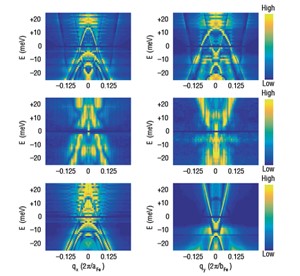
Strong electronic correlations, emerging from the parent Mott insulator phase, are key to copper-based high-temperature superconductivity. By contrast, the parent phase of an iron-based high-temperature superconductor is never a correlated insulator. However, this distinction may be deceptive because Fe has five active d-orbitals while Cu has only one. In theory, such orbital multiplicity can generate a Hund's metal state, in which alignment of the Fe spins suppresses inter-orbital fluctuations, producing orbitally selective strong correlations. The spectral weights Zm of quasiparticles associated with different Fe orbitals m should then be radically different. Here we use quasiparticle scattering interference resolved by orbital content to explore these predictions in FeSe. Signatures of strong, orbitally selective differences of quasiparticle Zm appear on all detectable bands over a wide energy range. Further, the quasiparticle interference amplitudes reveal that Zxy<Zxz<<Zyz, consistent with earlier orbital-selective Cooper pairing studies. Thus, orbital-selective strong correlations dominate the parent state of iron-based high-temperature superconductivity in FeSe.
published article - download PDF
(Nature Materials 17, 869 - Oct 2018)
News and Views article by Massimo Capone (PDF)
See also - BNL News
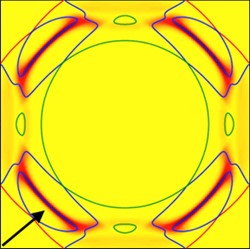
The cuprate pseudogap exhibits an unidentified unconventional density modulation, which is widely believed to be charge density wave (CDW). Recent theory indicates that it could actually be an electron-pair density wave (PDW) state. Here we demonstrate theoretically that a biaxial PDW state with 8a0 periodicity may provide a compelling quantitative explanation for much of the observed quantum oscillation data.
published article - download PDF
(Proc. Nat'l Aacd. Sci. 115, 5389 - 22 May 2018)
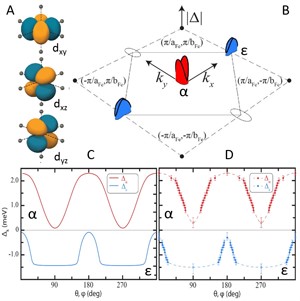
In Cu-based HTS materials, the undoped phase is a robust Mott insulator while, in Fe-based HTS materials, the undoped phase is generally not an insulator at all. Thus, proximity to a Mott insulator appears neither indispensable nor universal to HTS. However, theory predicts that Fe-based materials could still be governed by strong electronic correlations proximate to a Mott insulator if an orbital selective Mott phase (OSMP) exists. A key signature of OSMP would be orbital selective Cooper pairing wherein electrons of a specific orbital character predominantly form the Cooper pairs.
We used Bogoliubov quasiparticle interference imaging to determine the Fermi surface geometry and the corresponding superconducting energy gaps of the famous iron-based superconductor FeSe. We show that both gaps are extremely anisotropic but nodeless, and they exhibit gap maxima oriented orthogonally in momentum space. By introducing a novel technique, we demonstrate that these gaps have opposite sign with respect to each other. This complex gap configuration reveals the existence of orbital-selective Cooper pairing that, in FeSe, is based preferentially on electrons from the dyz orbitals of the iron atoms.
published article - download PDF
(Science 357, 75 - 7 Jul 2017)
See also - BNL News / Phys.org / Science Daily
Next Big Future / Irish Times / Chemie.deJournal Club for Condensed Matter Physics
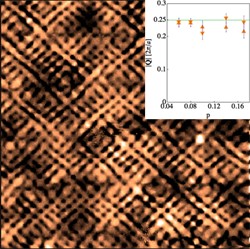
Phase-optimization analysis of the phase-resolved electronic structure reveals a virtually doping-independent locking of the local charge density modulation with four crystal unit cell periodicity throughout the underdoped phase diagram of the canonical cuprate Bi2Sr2CaCu2O8+x.
published article - download PDF
(Proc. Nat'l Acad. Sci. 113, 12661 - 8 Nov 2016)
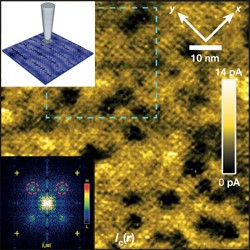
Theory predicts that the cuprate pseudogap phase should contain a spatially modulating Cooper-pair density wave (PDW) state. This would be akin to the famous FFLO state of spatially modulated conventional superconductivity, but generated by strong correlations instead of high magnetic fields. To search for a cuprate PDW, we developed a millikelvin scanned Josephson tunneling microscope (SJTM) system that can image Cooper-pair tunneling from a d-wave superconducting STM tip to the Cooper-pair condensate of Bi2Sr2CaCu2O8. Nanometer resolution condensate visualization then revealed a Cooper-pair density wave modulating along the Cu-O bond directions at wavevectors Qp ~ (1/4,0)*2π/a0; (0,1/4)*2π/a0.
published article - download PDF
(Nature 532, 343 - 21 Apr 2016)
See also - BNL news / Cornell Chronicle / Phys.org
EurekaAlert / Newswise / Science Daily / Sci-news
TechnoBuffalo /
Headlines & Global news / Kavli Foundation
The Science Explorer
* On Korean media : Chosun / NocutNews / Yohhap
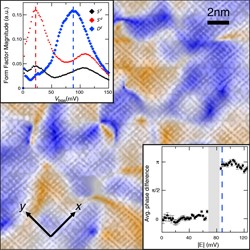
Energy-resolved sublattice visualization of the electronic structure reveals that the d-form-factor density wave states in underdoped cuprate involve particle-hole interactions focused at the pseudogap energy scale and between the four pairs of 'hot frontier' regions in momentum space where the pseudogap opens.
published article - download PDF
(Nature Physics 12, 150 - Feb 2016)
See also - Nanowerk / Phys.org
EurekaAlert / Newswise / Electronics weekly
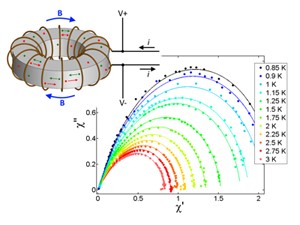
A classic "supercooled" liquid develops when a fluid does not crystallize upon cooling below its ordering temperature. Such liquids have specific identifiers including microscopic relaxation times diverging on a Vogel-Tammann-Fulcher (VTF) trajectory, a Havriliak-Negami (HN) form for the dielectric function, and a general Kohlrausch-Williams-Watts (KWW) form for time-domain relaxation. Recently, the magnetic state of the frustrated pyrochlore Dy2Ti2O7 has become of wide interest. By introducing novel magnetization transport measurement techniques, an improved understanding of the time- and frequency-dependent magnetization dynamics of Dy2Ti2O7 is achieved. We find that this system exhibits a virtually universal HN form for the magnetic susceptibility, a general KWW form for the real-time magnetic relaxation, and a divergence of the microscopic magnetic relaxation rates with the VTF trajectory. Low-temperature Dy2Ti2O7 therefore exhibits all the characteristics expected of a supercooled classical spin-liquid; we propose that this is the correct description of its magnetic state.
published article - download PDF
(Proc. Nat'l. Acad. Sci. 112, 8549 - Jul 2015)
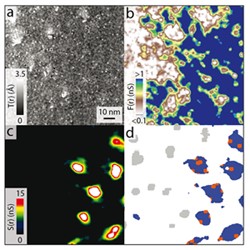
SI-STM study visualizes the atomic-scale effects of irradiating Fe(Se,Te) superconductor with high-energy heavy ions. Simultaneous imaging of defects, superconducting order parameter and vortex configuration reveals how columnar and point defects pin quantum vortices allowing high critical current density.
published article - download PDF
(Sci. Adv. 1, e1500033 - May 2015)
See also - Nanowerk / Phys.org
Eurekalert / Newswise
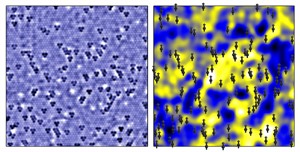
By introducing the Dirac-mass 'gapmap' technique, i.e. simultaneously visualizing the mass gap Δ(r) and the ferromagnetic dopant atoms in the atomic-scale, we discover intense nanoscale disorder in the Dirac-mass and demonstrate that this is directly related to fluctuations in the magnetic-dopant atom density n(r). (click the image for expanded version with scale bars)
published article - download PDF - movie [wmv]
(Proc. Nat'l Acad. Sci. 112, 1316 - Feb 2015)
See also - BNL news / Cornell Chronicle
Phys.org / Eurekalert / Newswise
/ Nanowerk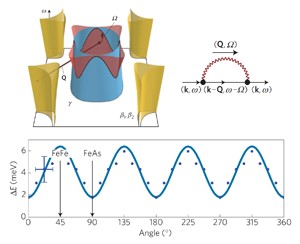
Quasiparticle Interference (QPI) imaging technique reveals that electron-boson interaction in LiFeAs superconductivity has momentum-space anisotropic self-energy 'fingerprint' of anti-ferromagnetic spin fluctuations.
published article - download PDF
(Nature Physics 11, 177 - Feb 2015)
See also - Phys.org / Cornell Chronicle / Rd World Online
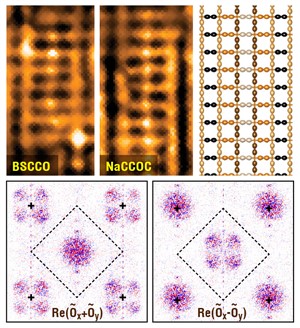
Direct sublattice-phase-resolved imaging of the electronic structure in both Bi2Sr2CaCu2O8+δ and Ca2-xNaxCuO2Cl2 reveals that the cuprate pseudogap phase exhibits a previously unknown electronic state: a d-symmetry form factor density wave.
published article - download PDF
(Proc. Nat'l. Acad. Sci. 111, E3026 - Jul 2014)
See also - Phys.org
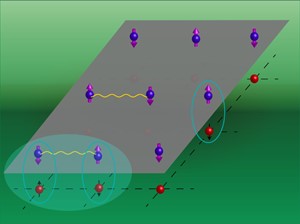
Quasiparticle interference imaging of heavy fermions reveals the momentum-space structure of the f-electron magnetism in CeCoIn5. Using this novel information, we then demonstrate directly and quantitatively that the Cooper pairing in this heavy fermion superconductor is mediated by the f-electron magnetic interactions.
published article - download PDF
(Proc. Nat'l. Acad. Sci. 111, 11663 - Aug 2014)
See also - Science Editor's choice
Superconductor Week (pg. 13) / Red Orbit
Int'l Business Times / Science Codex
Cornell Chronicle / Next big future
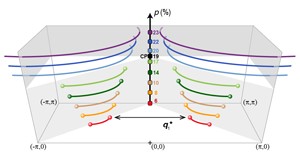
Abrupt transition in Bi2Sr2CaCu2O8+δ Fermi surface topology from broken 'arc' to full closed contour is visualized with SI-STM to occur at the same critical doping level where d-form factor density wave disappears.
(Click the image for enlarged version)
published article - download PDF
(Science 344, 612 - May 201 4)
BNL news / Phys.org / Eurekalert / Nanowerk
Nanotechnology Now / Science Codex / Wired
ScienceDaily / Newswise / StarDrive
Lab Manager / SC Week (pg. 8)
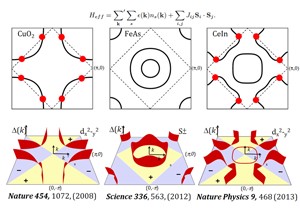
Rich ordering phenomena with distinct symmetry observed in proximity to the superconductivity of Cu-based / Fe-based / heavy-fermion compounds are explained in a unified theory based on antiferromagnetic interaction.
(Click the image for enlarged version)
published article - download PDF
(Proc. Nat'l. Acad. Sci. 110, 17623 - Oct 2013)
See also -
Ocnus / ScienceDaily / Phys.org
DemocraticUnderground /
Nanotechnology Now /
Press-News / Red Orbit /
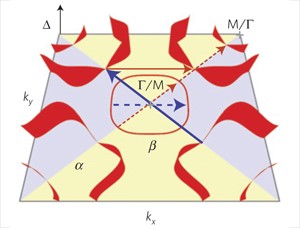
Complex band structure and the Fermi surface of CeCoIn5 is revealed in detail with QPI. Also visualized for the first time in heavy fermion superconductor compound is the superconducting energy gaps, shown to be consistent with dx2-y2 symmetry.
published article - download PDF
(Nature Physics 9, 468 - Aug 2013)
See also -
News and Views by Taillefer
Phys.org / ScienceDaily / EurekAlert /
Eureka! Science News / ScienceCodex /
Newswise / Nanotechnology Now
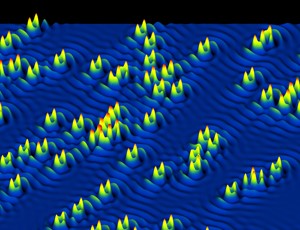
Dopant-induced impurity states in underdoped iron-based superconductor Ca(Fe1-xCox)2As2, resulting quasiparticle scattering, and its relation to the nematic transport of the parent phase are studied with SI-STM and ARPES.
published article - download PDF
(Nature Physics 9, 220 - Apr 2013)
See also -
TechConnect /
Phys.org /
Red orbit /
Nanotechnology now / R & D magazine
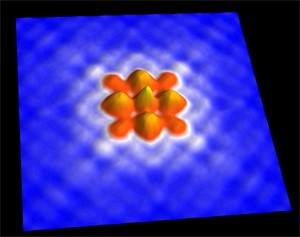
Zinc impurity states inside Bi2Sr2CaCu2O8+δ are located to pico-meter scale, providing phase information for intra-unit-cell Bragg-peak Fourier analysis.
published article - download PDF
(New Journal of Physics 14, 053017 - May 2012)
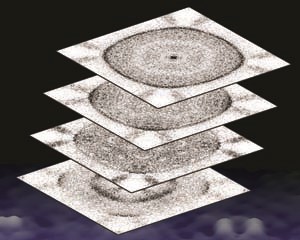
Anisotropic energy gaps of iron-based superconductor LiFeAs are determined from intra-band QPI analysis.
published article - download PDF
(Science 336, 563 - May 2012)
See also -
Article on Cornell Chronicle
Article on EurekaAlert
Article on ScienceDaily
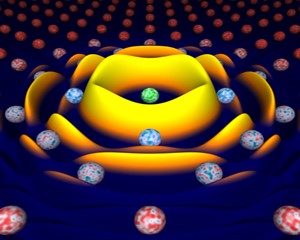
Electronic structure of Kondo holes in the Th-doped heavy Fermion compound URu2Si2 is visualized with STM to find heterogeneous hybridization strength in nanoscale.
published article - download PDF
(Proc. Nat'l Acad. Sci. 108, 18233 - Nov 2011)
See also -
Commentary by J. D. Thompson
Author Interview with Kavli Foundation
Article on Physorg.com
Article on Eurekaorg.com
News on ScienceDaily
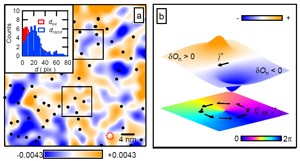
The 2π topological defects in the pseudogap phase of underdoped Bi2Sr2CaCu2O8+δ and the relationship between the coexistent smectic and intra-unit-cell broken symmetries are studied.
published article - download PDF
(Science 333, 426 - Jul 2011)
See also -
Binghamton University Research News
Article on Physorg.com
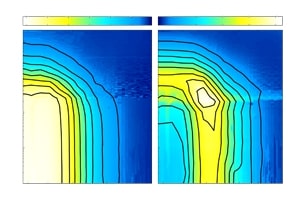
Interplay of rotational, relaxational and shear dynamics in solid 4He is investigated.
published article - download PDF
(Science 332, 821 - May 2011)
See also -
Nature NewsBlog by E. S. Reich
ScienceDaily news
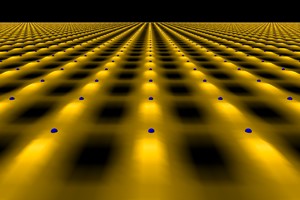
Electronic nematicity within unit cell in Bi2Sr2CaCu2O8+δ was studied with SI-STM.
published article - download PDF
(Nature 466, 347 - July 2010)
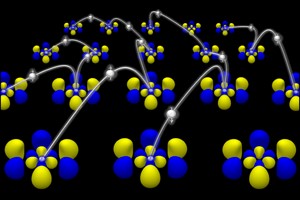
Heavy-fermion compound URu2Si2 is investigated in both real and momentum space with spectroscopic imaging (SI) - STM.
published article - download PDF
(Nature 465, 570 - June 2010)
See also -
News and Views by A. J. Schofield
(Nature 465, 553)
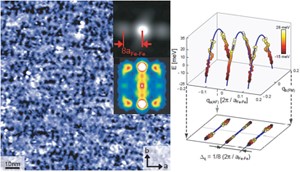
Nematic electronic structure in the parent state of the iron-based superconductor Ca(Fe1-xCox)2As2 is revealed by spectroscopic imaging (SI) STM measurements in both real-space and momentum-space.
published article - download PDF
(Science 327, 181 - January 2010)
See also -
Perspectives by E. Fradkin & S. A. Kivelson
(Science 327, 155)
Article on NewScientist by Colin Barras
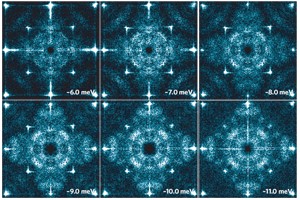
Heavy d-electron quasiparticle interferenc(QPI) patterns in k-space and sub-atomic electronic structure in r-space are revealed by spectroscopic imaging(SI) STM measurements on Sr3Ru2O7. A relevant band is also identified from the complicated band structure of Sr3Ru2O7 by inverting dispersing QPI patterns.
published article - download pdf
(Nature Physics 5, 800 - September 2009)
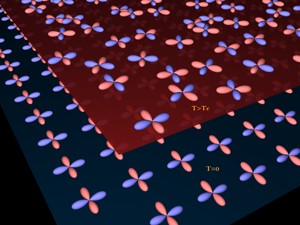
Quasiparticle interference imaging in the cuprate pseudogap state (T>Tc) reveals the spectro-scopic 'fingerprint' of phase incoherent d-wave superconductivity. (Click image to enlarge)
published article - download PDF
(Science 325, 1099 - August 2009)
See also -
Perspectives by Michael R. Norman
(Science 325, 1080)
Press release by Cornell University
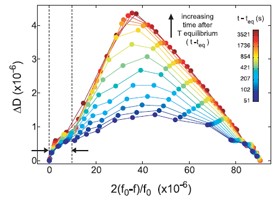
Relaxation study of 4He in the solid phase reveals ultraslow dynamics, evidencing the formation of superglass state.
published article - download PDF
(Science 324, 632 - May 2009)
See also -
Perspectives by John Saunders
(Science 324, 601)
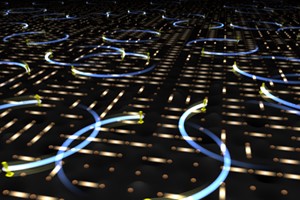
Investigation of the vanishing pattern of Cooper pairs in Bi2Sr2CaCu2O8+δ, approaching the Mott insulator.
published article - download PDF
(Nature 454, 1072 - Aug 2008)
See also -
Review by Tetsuo Hanaguri
(Nature 454, 1062)
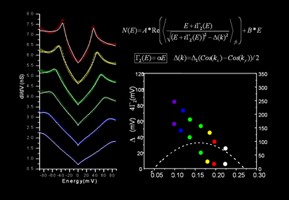
Evolution of the electronic excitation spectrum with strongly diminishing hole density in superconducting Bi2Sr2CaCu2O8+δ.
published article - download PDF
(Nature Physics 4, 319 - Apr 2008)
See also - review by Eric Hudson
(Nature Physics 4, 271)
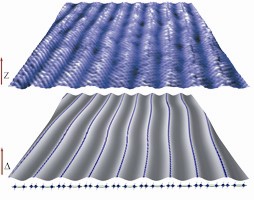
Imaging the impact on cuprate superconductivity of varying the interatomic distances within individual crystal cells .
published article - download PDF
(Proc. Nat'l Acad. Sci. Vol. 105, no. 9, 3203
- Mar 2008)
See also - comment by Michael R. Norman
(Proc. Nat'l Acad. Sci. Vol. 105, no. 9, 3173)
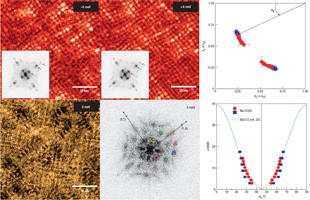
Quasiparticle interference of nearly optimally doped Ca2-xNaxCuO2Cl2 was studied using STS.
published article - download PDF
(Nature Physics 3, 865 - Oct 2007)
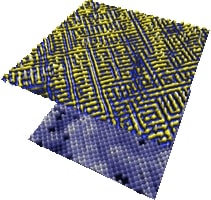
Atomic resolution tunneling asymmetry imaging: an intrinsic Cu-O-Cu bond-centered electronic glass with disperse 4a0-wide unidirectional domains in underdoped Ca1.88Na0.12CuO2Cl2 and Bi2Sr2Dy0.2Ca0.8Cu2O8+δ
published article - download PDF
(Science 315, 1380 - Mar 2007)
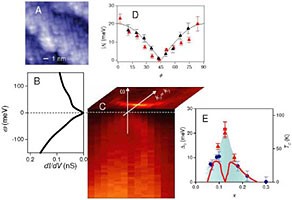
The pseudogap state in cuprate superconductors La2-xBaxCuO4 (x=1/8) was studied by ARPES and STM.
published article - download PDF
(Science 314, 1914 - Dec 2006)
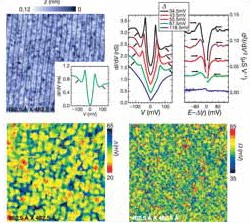
The influence of atomic scale electron-lattice interactions on high-Tc superconductivity was imaged by STM.
published article - download PDF
(Nature 442, 546 - Aug 2006)
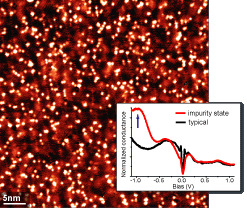
Atomic-scale sources and mechanism of nanoscale electronic disorder in Bi2Sr2CaCu2O8+δ were identified by STM.
published article - download PDF
(Science 309, 1048 - Aug 2005)
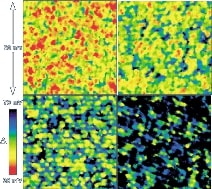
The doping dependence of nanoscale electronic structure in superconducting Bi2Sr2CaCu2O8+δ was studied by STM.
published article - download PDF
(Phys. Rev. Lett. 94, 197005 - May 2005)
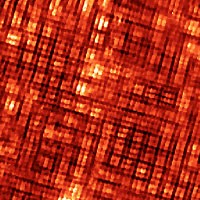
'Checkerboard' electronic crystal state in the lightly hole-doped cuprate Ca2-xNaxCuO2Cl2.
published article - download PDF
(Nature 430, 1001 - Aug 2004)
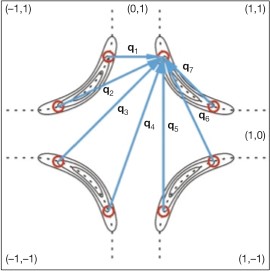
The relationship between atomic-scale electronic phenomena and wave-like quasiparticle states in superconducting Bi2Sr2CaCu2O8+δ was explained in terms of an octet model of quasiparticle interference.
published article - download PDF
(Nature 422, 592 - Apr 2003)
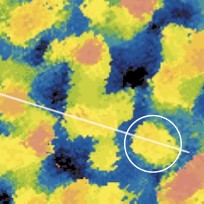
The granular structure of high-Tc superconductivity in underdoped Bi2Sr2CaCu2O8+δ was imaged with atomic resolution, revealing inherent heterogeneity.
published article - download PDF
(Nature 415, 412 - Jan 2002)
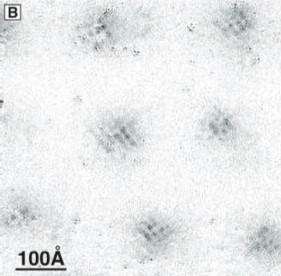
A checkerboard-like Four Unit Cell Periodic Pattern of Quasi-Particle States Surrounding Vortex Cores in Bi2Sr2CaCu2O8+δ was discovered.
published article - download PDF
(Science 295, 466 - Jan 2002)
